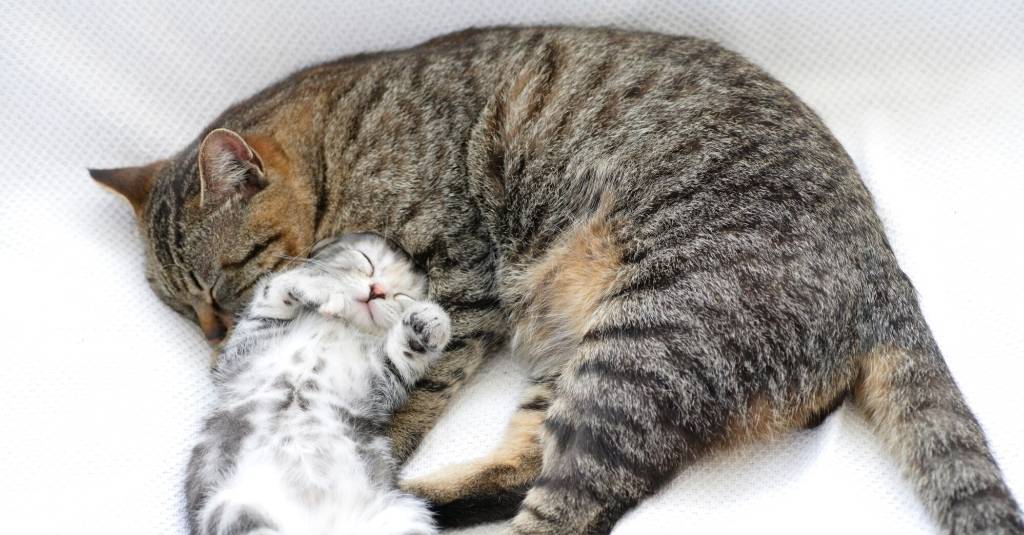anxiety & aggression support

free shipping over $100 (USA & Canada)
1-877-937-4372 the pet expert hotline

Natural Help for Stress Reduction, Anxiety Relief, Behavioral Problems, and Aggression in Cats


You might be excited for the newest addition to your fur family, but your other cats already in your household might not share the same enthusiasm. A new cat member can often cause jealousy, competition, and fights. It may not be the pleasant experience for either party that you were expecting.
To avoid any negative feelings towards each other and unnecessary stress, we have provided a few suggestions for introducing two cats to each other.
One way to introduce a new cat or kitten to an existing cat is through slow interaction.
Put the new kitty in a separate room and close the door. Provide each with access to a litter box, food and water, and a hiding place like a cat tent or even a cardboard box with a blanket or towel in it.
After your new kitty has had time to adjust to its new space, you can start scent swapping by bringing an article that your resident cat often uses (ex. a blanket) and placing it near the new kitty’s food dish and vice versa. This will allow both of them to get used to eating in the presence of the other kitty’s scent.
If there is no hissing or growling at the item, then at the next feeding, swap food bowls between the two. If there is hissing or growling at the item, move it further away, where they can approach it at their leisure.
Using a cloth or small towel, pet one cat around the cheek area as this is where they release “friendly” hormones. Then take the cloth or towel and pet the other kitty in the same way. This will help them get used to the scent in a friendly manner. You can also further the “friendly” feelings towards these scents by giving them a small treat every time you introduce a scented item.
The next step is to place a food dish somewhat near (but not too close) to each side of the door to feel comfortable eating without feeling threatened, although they will know that another cat is present. Gradually move the food dishes closer to the door so that they are more in each other’s presence but still separated.
In addition to this, you can try switching their designated areas as well. Try putting your original kitty in the room while letting the new kitty roam around. This will allow them to get used to being in the same space with the other cat’s scent and get used to the environment on a grander scale.
Eventually, prop open the door to see and smell each other but cannot get through. This will allow them to approach at their will and allow either one, if threatened, to retreat.
All pets will fear change, and some cats may have greater difficulty adjusting than others.
Once you feel that there is no aggression towards each other, you can let them meet fully. If any aggression occurs, make a loud noise or toss something on the floor (like a set of keys) to distract their attention and hopefully end the potential fight. If that does not work, you may need to split them up and slowly reintroduce them.
Keep in mind that some small signs of aggression, like hissing or posturing, but no actual attacking, may be a determination of hierarchy and establishing the pecking order between themselves to live together. If it is prolonged or progresses into physical contact, you will need to separate them and go back to where they were comfortable in the introduction.
Do not leave the cats alone together for the first little while, even if the face-to-face seems to have gone well. The new kitty should be returned to their room when no one is home to avoid any fighting or bullying when the parents are out.
Just like human siblings, sometimes cats can get along; eat out of the same bowls, share beds, and a litter box, whereas other times they may be able to live together but will require separate food bowls, sleeping areas, and litter boxes.
All pets will fear change, and some cats may have greater difficulty adjusting than others. It’s a good idea to try using a natural supplement to help calm the nerves. We recommend NHV Matricalm for cats. Ideally, you will start using the NHV Matricalm with the cat in the household for a couple of weeks before the new cat or kitten arrives. In addition to calming the nerves, Matricalm will help reduce aggression and is even safe for puppies and kittens.
You may also want to try giving healthy treats, like My Little Lion cat treats, to each kitty for good behavior. Feel free to reach out to our veterinarian, Dr. Amanda, if you have any questions regarding your pet health.
anxiety & aggression support

For stress, anxiety, behavioral problems in birds
buy 2 and save $3
3 month supply for a small to medium size pet



Birds can be prone to stress and anxiety, which can lead to other health conditions such as feather plucking. Help to reduce stress and anxiety in your bird with Matricalm, a natural herbal product designed to help reduce excitability in your pet.
Chamomile – Contains sedative properties.
Passion Flower – An effective, non-addictive sedative.
Lemon Balm – An aromatic herb used for nervous disorders, excitability, and anxiety.
Valerian – Stops heart palpitations, relaxes spasms, relieves pain, and regulates the nervous system.
Hops – Eases tension and anxiety in pets.
For birds: 1 drop per two pounds twice a day
How to Administer
Shake well before use. The easiest method is to use the dropper provide and place the drops into your bird's favorite treat. You can also use the dropper and squirt directly into the bird’s mouth.
For Best Results
Herbal dietary supplements are beneficial to the health and wellbeing of your pet and are safe for long-term use. Every pet responds to natural herbal supplements differently, therefore it is important to be consistent and administer the product daily. Supplements generally take two to four weeks to take effect, however this will vary from one animal to the next.
Product Storage
All NHV Natural Pet Products are pure herbal extracts and contain no artificial additives, preservatives or coloring. Shelf life after opening is 6 months and must be refrigerated after opening.
Cautions and Contraindications
Do not use Matricalm in pregnant or nursing animals. Speak to your vet before using our products. A second visit is recommended if your pet’s condition does not improve, or deteriorates after continued use of the supplements.
All information provided by NHV Natural Pet Products is for educational purposes only.
Birds can be prone to stress and anxiety, which can lead to other health conditions such as feather plucking. Help to reduce stress and anxiety in your bird with Matricalm, a natural herbal product designed to help reduce excitability in your pet.
Chamomile – Contains sedative properties.
Passion Flower – An effective, non-addictive sedative.
Lemon Balm – An aromatic herb used for nervous disorders, excitability, and anxiety.
Valerian – Stops heart palpitations, relaxes spasms, relieves pain, and regulates the nervous system.
Hops – Eases tension and anxiety in pets.
For birds: 1 drop per two pounds twice a day
How to Administer
Shake well before use. The easiest method is to use the dropper provide and place the drops into your bird's favorite treat. You can also use the dropper and squirt directly into the bird’s mouth.
For Best Results
Herbal dietary supplements are beneficial to the health and wellbeing of your pet and are safe for long-term use. Every pet responds to natural herbal supplements differently, therefore it is important to be consistent and administer the product daily. Supplements generally take two to four weeks to take effect, however this will vary from one animal to the next.
Product Storage
All NHV Natural Pet Products are pure herbal extracts and contain no artificial additives, preservatives or coloring. Shelf life after opening is 6 months and must be refrigerated after opening.
Cautions and Contraindications
Do not use Matricalm in pregnant or nursing animals. Speak to your vet before using our products. A second visit is recommended if your pet’s condition does not improve, or deteriorates after continued use of the supplements.
All information provided by NHV Natural Pet Products is for educational purposes only.
stress & anxiety support

Natural Support for Canine Stress and Anxiety
buy 2 and save $3
3 month supply for a small to medium size pet
Everyone knows what stress feels like, and we all know that too much stress can make us ill—high blood pressure, ulcers and even cancer can result from excessive stress. Like us, dogs can get stressed by numerous factors as well. Help your furkiddo relax into a long and happy life with NHV Lesstress - a natural dog stress support.


Everyone knows what stress feels like, and we all know that too much stress can make us ill—high blood pressure, ulcers and even cancer can result from excessive stress. Like us, dogs can get stressed by numerous factors as well. Help your furkiddo relax into a long and happy life with NHV Lesstress - a natural dog stress support.

Natural Dog Stress Reliever Supplemental Support
With a heightened sense of hearing and smell, small events that seem mundane to us can be terrifying and stressful for your dogs. Sometimes the stress is from the ride to the office, or maybe they are missing their human companions. This all contributes to changes in behavior like excessive panting, drooling, sweaty paws, dilated eyes, pacing, excessively shedding, or just completely shutting down. Some dogs become so stressed that it may lead to fear and aggression.
Other forms of stress in a dog’s life include:
In addition to panting, excessive barking/whining, chewing on themselves, shivering (when it’s not cold), panicked tail wagging, or tense muscles, stress can also cause GI tract issues such as diarrhea or vomiting.
The key to a healthy pup is balance. Too much or too little activity can be harmful, as well as too much or too little socialization. A balanced, clean diet also helps maintain the body and the mind. If your dog is susceptible to stress, you can use calming herbs like those found in NHV Lesstress. This formulation gently acts on the nervous system and immune system to provide a natural dog stress reliever.
How NHV’s Natural Dog Stress Relief Eases Stress and Anxiety
For stressful experiences such as separation anxiety, the loss or addition of a furry friend, special events (eg. fireworks) and illness (stress can cause conditions to worsen), the natural (non-addictive) sedative properties of Lesstress gently relax the nervous system and endocrine system. Ingredients like Chamomile, Passion Flower and Lemon Balm work to calm nerves while ingredients like Reishi, Eleuthero, and Echinacea Angustifolia are very beneficial for helping the body adapt to stress and illness and stimulate healthy immune function.
Help Support Your Dog Naturally
All NHV supplements like Lesstress are 100% natural and created by a holistic veterinarian and a master herbalist, specially formulated for pets. Feel free to contact our veterinary professionals to get more insight into your little one’s health and wellbeing.
Made with the finest, organically grown, or ethically harvested herbs. Made specifically for pets, vet-formulated and vet approved.
Lesstress for Dogs
Select your pet's weight to determine the correct dose.
To be taken twice daily. Determine your pet’s weight and then use the easy chart below to determine the correct dose. This is the minimum dosage.
Pet's Weight Dosage
0 - 15 lb = 0.5 ml
16 - 30 lb = 1.0 ml
31 - 45 lb = 1.5 ml
46 - 60 lb = 2.0 ml
61 - 75 lb = 2.5 ml
Over 75 lb = 3.0 ml
For small animals (rabbits, ferrets), avians and reptiles use 1 drop for every 2 lb of body weight.
How to Administer
Shake well before use.
The easiest method is to use the dropper provide and places the drops into your pet’s food or favorite treat. You can also use the dropper and squirt directly into the pet’s mouth.
Some pets can be finicky, if this occurs consider hiding the drops in foods most pet’s love such as fish, chicken or yogurt or a favourite treat. If your pet only eats dry food then soak a few kibbles at feeding time.
For Best Results
Herbal dietary supplements are beneficial to the health and wellbeing of your pet and are safe for long-term use. Every pet responds to natural herbal supplements differently, therefore it is important to be consistent and administer the product daily. Supplements generally take two to four weeks to take effect, however this will vary from one animal to the next.
Product Storage
All NHV Natural Pet Products are pure herbal extracts and contain no artificial additives, preservatives or coloring. Shelf life after opening is 6 months and must be refrigerated after opening.
Cautions and Contraindications
Do not use Lesstress in pregnant or nursing animals.
Speak to your vet before using our products. A second visit is recommended if your pet’s condition does not improve, or deteriorates after continued use of the supplements.
All information provided by NHV Natural Pet Products is for educational purposes only.
Natural Dog Stress Reliever Supplemental Support
With a heightened sense of hearing and smell, small events that seem mundane to us can be terrifying and stressful for your dogs. Sometimes the stress is from the ride to the office, or maybe they are missing their human companions. This all contributes to changes in behavior like excessive panting, drooling, sweaty paws, dilated eyes, pacing, excessively shedding, or just completely shutting down. Some dogs become so stressed that it may lead to fear and aggression.
Other forms of stress in a dog’s life include:
In addition to panting, excessive barking/whining, chewing on themselves, shivering (when it’s not cold), panicked tail wagging, or tense muscles, stress can also cause GI tract issues such as diarrhea or vomiting.
The key to a healthy pup is balance. Too much or too little activity can be harmful, as well as too much or too little socialization. A balanced, clean diet also helps maintain the body and the mind. If your dog is susceptible to stress, you can use calming herbs like those found in NHV Lesstress. This formulation gently acts on the nervous system and immune system to provide a natural dog stress reliever.
How NHV’s Natural Dog Stress Relief Eases Stress and Anxiety
For stressful experiences such as separation anxiety, the loss or addition of a furry friend, special events (eg. fireworks) and illness (stress can cause conditions to worsen), the natural (non-addictive) sedative properties of Lesstress gently relax the nervous system and endocrine system. Ingredients like Chamomile, Passion Flower and Lemon Balm work to calm nerves while ingredients like Reishi, Eleuthero, and Echinacea Angustifolia are very beneficial for helping the body adapt to stress and illness and stimulate healthy immune function.
Help Support Your Dog Naturally
All NHV supplements like Lesstress are 100% natural and created by a holistic veterinarian and a master herbalist, specially formulated for pets. Feel free to contact our veterinary professionals to get more insight into your little one’s health and wellbeing.
Made with the finest, organically grown, or ethically harvested herbs. Made specifically for pets, vet-formulated and vet approved.
Lesstress for Dogs
Select your pet's weight to determine the correct dose.
To be taken twice daily. Determine your pet’s weight and then use the easy chart below to determine the correct dose. This is the minimum dosage.
Pet's Weight Dosage
0 - 15 lb = 0.5 ml
16 - 30 lb = 1.0 ml
31 - 45 lb = 1.5 ml
46 - 60 lb = 2.0 ml
61 - 75 lb = 2.5 ml
Over 75 lb = 3.0 ml
For small animals (rabbits, ferrets), avians and reptiles use 1 drop for every 2 lb of body weight.
How to Administer
Shake well before use.
The easiest method is to use the dropper provide and places the drops into your pet’s food or favorite treat. You can also use the dropper and squirt directly into the pet’s mouth.
Some pets can be finicky, if this occurs consider hiding the drops in foods most pet’s love such as fish, chicken or yogurt or a favourite treat. If your pet only eats dry food then soak a few kibbles at feeding time.
For Best Results
Herbal dietary supplements are beneficial to the health and wellbeing of your pet and are safe for long-term use. Every pet responds to natural herbal supplements differently, therefore it is important to be consistent and administer the product daily. Supplements generally take two to four weeks to take effect, however this will vary from one animal to the next.
Product Storage
All NHV Natural Pet Products are pure herbal extracts and contain no artificial additives, preservatives or coloring. Shelf life after opening is 6 months and must be refrigerated after opening.
Cautions and Contraindications
Do not use Lesstress in pregnant or nursing animals.
Speak to your vet before using our products. A second visit is recommended if your pet’s condition does not improve, or deteriorates after continued use of the supplements.
All information provided by NHV Natural Pet Products is for educational purposes only.
general wellbeing

Newly adopted pets are often quite stressed. They have spent time in the shelter, removed from their previous home or even from time roaming the streets. Though they are happy to have found a forever home, all of these changes can be quite stressful and can cause some undesirable behaviors. Matricalm is an all-natural supplement designed to reduce anxiety, stress and undesirable behaviors in pets.
Newly adopted pets can often use nutritional support. Whether they are malnourished from being stray, not eating because of stress in the shelter or just adjusting to their new home, Multi Essentials can help to fill nutritional voids. This all-natural herbal multivitamin that can help to support your pet's health throughout their life.
Stress and anxiety can cause gastrointestinal upset. Plantaeris can help to soothe and relieve spasms of the digestive tract which may cause diarrhea. It works quickly and gently to help promote normal bowel function.
bundle and save with pet expert kits
3 month supply for a small to medium size
Newly adopted pets are often quite stressed. They have spent time in the shelter, removed from their previous home or even from time roaming the streets. This can lead to undesirable behavior and decreased appetite as they adjust to their new home. This blend of supplements can help your new pet's transition into their forever home be as stress-free and seamless as possible.

Newly adopted pets are often quite stressed. They have spent time in the shelter, removed from their previous home or even from time roaming the streets. This can lead to undesirable behavior and decreased appetite as they adjust to their new home. This blend of supplements can help your new pet's transition into their forever home be as stress-free and seamless as possible.
MATRICALM
Chamomile – Contains sedative properties.
Passion Flower – An effective, non-addictive sedative.
Lemon Balm – An aromatic herb used for nervous disorders, excitability, and anxiety.
Valerian – Stops heart palpitations, relaxes spasms, relieves discomfort, and regulates the nervous system.
Hops – Eases tension and anxiety in pets.
MULTI ESSENTIALS
Alfalfa – Contains high protein levels (50%), vitamins, amino acids, minerals, sugars, and other nutrients.
Oat – Contains gluten, vitamins, and minerals (Ca, P, Mn, Cu, Zn, Fe).
Dandelion– A highly nutritious food that stimulates liver secretions, improves digestion, and stimulates the appetite.
Kelp – Rich in macrominerals (Ca, K, Mg) and trace minerals.
Parsley – Contains protein (up to 22%), vitamins (A, C, B1, B2, K), and minerals (Ca, K, Fe, Mg, P).
Marshmallow – Contains high levels of Ca.
Chickweed – A highly nutritious digestive tonic.
Stinging Nettle – Contains vitamins, minerals, and other nutrients.
PLANTAERIS
Barberry – Treats inflammation and infections of the urinary tract.
Mullein – Soothes and lubricates tissues.
Bayberry – Contains tannins, resins, and gums that control bacterial infection.
Myrrh – Relieves spasms, inflammation, and digestive discomfort.
Thyme – Improves digestion and relaxes spasms.
Chamomile – Relaxes the digestive system.
Chinese Peony – Reduces inflammation and relaxes spasms.
Ginger – Relieves discomfort and stimulates circulation.
Oregon Grape – Helps relieve indigestion and malabsorption.
To be taken twice daily. (Each supplement) Determine your pet’s weight and then use the easy chart below to determine the correct dose. This is the minimum dosage.
Pet's Weight Dosage
0 - 15 lb = 0.5 ml
16 - 30 lb = 1.0 ml
31 - 45 lb = 1.5 ml
46 - 60 lb = 2.0 ml
61 - 75 lb = 2.5 ml
Over 75 lb = 3.0 ml
For small animals (rabbits, ferrets), avians and reptiles use 1 drop for every 2 lb of body weight.
Long term use: Feed recommended dosage every other day (1 day on 1 day off). If used in large dosages or over a long period of time it may become irritating to the stomach lining. Some pets may require a larger dosage due to their metabolism. You can safely double the recommended dosage.
How to Administer: Shake well before use. The easiest method is to use the dropper provided and place the drops into your pet’s food or favorite treat. You can also use the dropper and squirt directly into the pet’s mouth. Some pets can be finicky, if this occurs consider hiding the drops in foods most pet’s love such as fish, chicken or yogurt or a favourite treat. If your pet only eats dry food then soak a few kibbles at feeding time.
For Best Results: Herbal dietary supplements are beneficial to the health and well-being of your pet and are safe for long-term use. Every pet responds to natural herbal supplements differently, therefore it is important to be consistent and administer the product daily. Supplements generally take two to four weeks to take effect, however this will vary from one animal to the next.
Product Storage: All NHV Natural Pet Products are pure herbal extracts and contain no artificial additives, preservatives or coloring. Shelf life after opening is 6 months and must be refrigerated after opening.
Cautions and Contraindications: Do not use Yucca in pregnant or nursing animals. Allowing breaks in feeding helps alleviate the possibility of a irritating effect on the digestive tract. Speak to your vet before using our products. A second visit is recommended if your pet’s condition does not improve, or deteriorates after continued use of the supplements. All information provided by NHV Natural Pet Products is for educational purposes only.
Select your pet's weight to determine the correct dose.
This kit can absolutely help. The supplements were chosen for their support for anxiety.
This kit can help to support anxiety, nutrition and GI troubles. They are all safe to give if your pet has other conditions. Seek veterinary advice if you suspect your pet is unwell
Even if pets are over-all healthy, their bodies can be affected by stress. This kit would be a great way to keep your pet stress free and healthy when brought in to a new home
We recommend using this kit until your new pet happily settles into your home, generally we would expect for about 3 months.
MATRICALM
Chamomile – Contains sedative properties.
Passion Flower – An effective, non-addictive sedative.
Lemon Balm – An aromatic herb used for nervous disorders, excitability, and anxiety.
Valerian – Stops heart palpitations, relaxes spasms, relieves discomfort, and regulates the nervous system.
Hops – Eases tension and anxiety in pets.
MULTI ESSENTIALS
Alfalfa – Contains high protein levels (50%), vitamins, amino acids, minerals, sugars, and other nutrients.
Oat – Contains gluten, vitamins, and minerals (Ca, P, Mn, Cu, Zn, Fe).
Dandelion– A highly nutritious food that stimulates liver secretions, improves digestion, and stimulates the appetite.
Kelp – Rich in macrominerals (Ca, K, Mg) and trace minerals.
Parsley – Contains protein (up to 22%), vitamins (A, C, B1, B2, K), and minerals (Ca, K, Fe, Mg, P).
Marshmallow – Contains high levels of Ca.
Chickweed – A highly nutritious digestive tonic.
Stinging Nettle – Contains vitamins, minerals, and other nutrients.
PLANTAERIS
Barberry – Treats inflammation and infections of the urinary tract.
Mullein – Soothes and lubricates tissues.
Bayberry – Contains tannins, resins, and gums that control bacterial infection.
Myrrh – Relieves spasms, inflammation, and digestive discomfort.
Thyme – Improves digestion and relaxes spasms.
Chamomile – Relaxes the digestive system.
Chinese Peony – Reduces inflammation and relaxes spasms.
Ginger – Relieves discomfort and stimulates circulation.
Oregon Grape – Helps relieve indigestion and malabsorption.
To be taken twice daily. (Each supplement) Determine your pet’s weight and then use the easy chart below to determine the correct dose. This is the minimum dosage.
Pet's Weight Dosage
0 - 15 lb = 0.5 ml
16 - 30 lb = 1.0 ml
31 - 45 lb = 1.5 ml
46 - 60 lb = 2.0 ml
61 - 75 lb = 2.5 ml
Over 75 lb = 3.0 ml
For small animals (rabbits, ferrets), avians and reptiles use 1 drop for every 2 lb of body weight.
Long term use: Feed recommended dosage every other day (1 day on 1 day off). If used in large dosages or over a long period of time it may become irritating to the stomach lining. Some pets may require a larger dosage due to their metabolism. You can safely double the recommended dosage.
How to Administer: Shake well before use. The easiest method is to use the dropper provided and place the drops into your pet’s food or favorite treat. You can also use the dropper and squirt directly into the pet’s mouth. Some pets can be finicky, if this occurs consider hiding the drops in foods most pet’s love such as fish, chicken or yogurt or a favourite treat. If your pet only eats dry food then soak a few kibbles at feeding time.
For Best Results: Herbal dietary supplements are beneficial to the health and well-being of your pet and are safe for long-term use. Every pet responds to natural herbal supplements differently, therefore it is important to be consistent and administer the product daily. Supplements generally take two to four weeks to take effect, however this will vary from one animal to the next.
Product Storage: All NHV Natural Pet Products are pure herbal extracts and contain no artificial additives, preservatives or coloring. Shelf life after opening is 6 months and must be refrigerated after opening.
Cautions and Contraindications: Do not use Yucca in pregnant or nursing animals. Allowing breaks in feeding helps alleviate the possibility of a irritating effect on the digestive tract. Speak to your vet before using our products. A second visit is recommended if your pet’s condition does not improve, or deteriorates after continued use of the supplements. All information provided by NHV Natural Pet Products is for educational purposes only.
Select your pet's weight to determine the correct dose.
This kit can absolutely help. The supplements were chosen for their support for anxiety.
This kit can help to support anxiety, nutrition and GI troubles. They are all safe to give if your pet has other conditions. Seek veterinary advice if you suspect your pet is unwell
Even if pets are over-all healthy, their bodies can be affected by stress. This kit would be a great way to keep your pet stress free and healthy when brought in to a new home
We recommend using this kit until your new pet happily settles into your home, generally we would expect for about 3 months.
Published: June 14, 2016